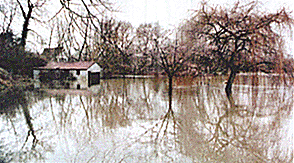 |
And today's forecast is...chaotic
|
Bill Burroughs explains why the weather gets stuck in a mood,and
so defies prediction
 |
| Water,water everywhere in Marlow,Buckinghamshire on 5 January: unexpected weather variations predate the last Ice Age |
In case you hadn't noticed,it has been
raining a lot recently.Total rainfall
from September to November was 34 per cent above the long term average for
England and Wales.December was wetter still - 57 per cent above average.
Every winter the weather "gets stuck" in one of a limited number of well
defined patterns.Here in Britain the most recognisable of these is the mild
and wet westerly conditions associated with the deep depression close to
Iceland.In late November,however,the pattern changed to the cold easterly
weather that occurs when high pressure lurks over Scandinavia.
For around three-quarters of each winter the atmospheric circulation
falls in one of four or five of these patterns.Once established,a given regime
may persist for several days or longer.During such a quasi-stationary
situation,the weather behaves in a more predictable
manner.But when the regime breaks down,the change is often rapid and
unexpected.
This relative stability punctuated by sudden less predictable
changes has profound implications for both day-to-day weather forecasting
and predicting the nature of future change.It means the accuracy of
weather forecasts will vary
substantially with the changing with the changing global circulation patterns.It
also influences how the climate responds to perturbations,such as the build-up
of carbon-dioxide due to the burning of fossil fuels - responses that may
more subtle than computer models suggest.
The response of the atmosphere to changes in its physical properties
is
non-linear.So as one parameter
changes,others alter in a way that is in direct proportion to this change.This
non-linear behaviour to Chaos Theory,and the problems
of weather forecasting and the climate prediction are classic examples of
this discipline.
In the case of weather forecasting,this means that the quality
of the forecasts is sometimes highly sensitive to the uncertainties in measuring
the initial state of the atmosphere.This variation in performance tends to
reflect whether the atmosphere is in transition between quasi-stationary
states or is stuck in one mode.But because of uncertainty about the switch
between the states it is impossible to tell by inspection whether a change
will occur during the forecast period and hence whether the forecast will
be good or bad.
One way to tackle this problem is to see how the predictions
behave when slightly different starting conditions are used to reflect the
uncertainty about the current state of the atmosphere.If,with a subtle range
of starting conditions,the ensemble of forecasts look remarkably similar
up to 10 days ahead,then there is a good chance that they are on the right
track.If,however,each forecast diverges significantly after a few days,then
clearly the atmosphere is in a less predictable mood.
At the European Center for Medium Range Weather Forecasts near
Reading,Tim Palmer has been
researching ensemble forecasting for many years.The center now produces blocks
of 33 ten-day forecasts each weekend.These show that it is possible to get
a much better fix on when the weather is in a predictable regime,and this
will place increasing pressure on forecasters to provide a statement on the
quality of their output.
When modelling climatic change,the effects of
non-linearity are best examined in a
different way.If the climate is subjected to a small perturbation -
say the result of natural fluctuations in ocean currents or the build up
of atmospheric carbon dioxide - its impact will vary depending on the state
of the atmosphere.When it is stuck in a well defined regime it may be of
little consequence,but when in transition it could have quite an effect on
which state the atmosphere next settles into.So even if the different regimes
basically remain unaltered by the perturbation,the proportion of time each
quasi-stationary state lasts could shift substantially and with the global
climate.
The consequence of this interpretation,as Dr Palmer expounded
recently in the magazine Weather,is to suggest that the impact of
a given increase in carbon dioxide may not necessarily be a proportionate
global warming. Intuition suggests this
perturbation would make warmer regimes more probable.In northern winters
this perturbation effectively tilts the climate in favour of spending more
time in the mild westerly regime.But this is not a forgone conclusion,and
the reverse,in which the colder blocked pattern prevails,cannot be ruled
out.
The test for the global computer models (which predict that
increased carbon dioxide leads to global warming) is whether they can simulate
the statistics of different quasi-stationary patterns.In practice,they do
not rise to this challenge well.So there is suspicion that they are
producing an over-simplified incremental response that may not reflect the
real consequence of the non-linearity of the climate.
This conclusion is not merely a theoretical hypothesis.Recent
results from new ice cores drilled in Greenland have suggested increasing
evidence of chaotic behaviour in the climate.In particular they have produced
dramatic insights into climatic variations during the warm period before
the last Ice Age.
Because the temperature during this interglacial period,known as the Eemian,was
higher than at present,it had been assumed that it might be a good model
for predicting the consequences of global warming.What seems to have emerged
from the new observations was wholly unexpected.Instead of relatively
stable warm climate,there appear to have been three different climatic
states.Shifts between these states took place suddenly,within a decade or
so,sometimes involving average temperature changes of 10C or more,and lasted
anything from 70 to 5,000 years.
Measurements of parallel variations in dust level in the ice cores suggest
that the fluctuations in climate were associated with significant switches
in atmospheric circulation patterns.It is postulated that these shifts may
have been driven by sudden alterations in the circulation of the
oceans.But,whatever the explanation, they provide a chilling reminder
of how non-linear responses to climatic perturbations can be amplified
by the changing prevalence of atmospheric circulation regimes.They also indicate
that,it is not safe to assume that the response of the global climate to
the build-up of carbon dioxide will be gradual,nor that it is absolutely
certain to lead to global warming.
Farmers who reap what they see in the stars
Farmers often lament how clueless people are these days about
where their food comes from. As a townie I must admit that I had no idea
harvest festival was approaching until I heard how churchgoers in Gloucestershire
had been banned from donating tins of baked beans because
vicars just can't give them away. |
UK Met Office | Climate Prediction | Marine Weather | Weather Answers
Building Your Disaster Supply Kit | What to Do to Keep Your Dog Safe Before and During a Flood | What you should do if you get stuck driving in floodwaters | How to Recover After a Hurricane | Safe Cleaning After a Home Flood - What You Need to Know | Mold and Flooded Homes